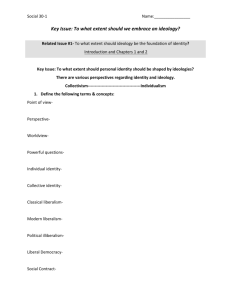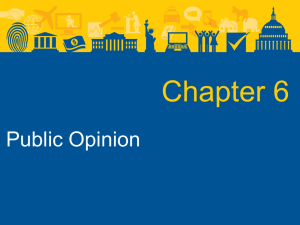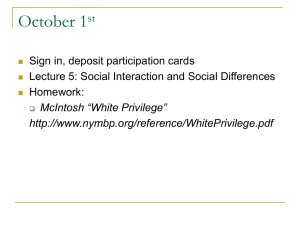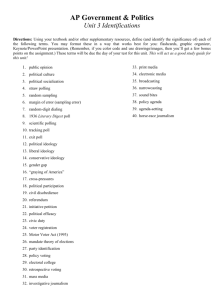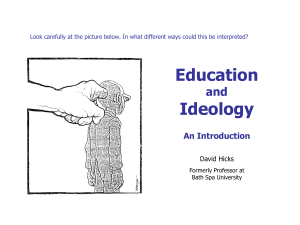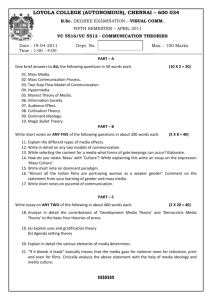Ch 1 Questions
advertisement
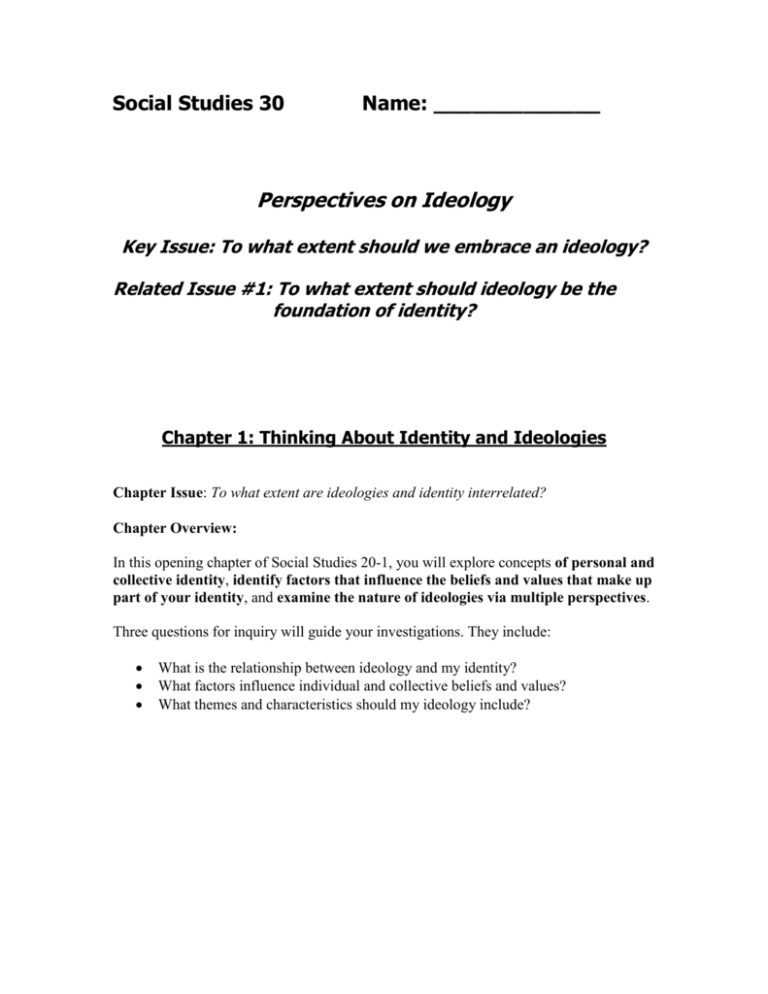
Social Studies 30 Name: _____________ Perspectives on Ideology Key Issue: To what extent should we embrace an ideology? Related Issue #1: To what extent should ideology be the foundation of identity? Chapter 1: Thinking About Identity and Ideologies Chapter Issue: To what extent are ideologies and identity interrelated? Chapter Overview: In this opening chapter of Social Studies 20-1, you will explore concepts of personal and collective identity, identify factors that influence the beliefs and values that make up part of your identity, and examine the nature of ideologies via multiple perspectives. Three questions for inquiry will guide your investigations. They include: What is the relationship between ideology and my identity? What factors influence individual and collective beliefs and values? What themes and characteristics should my ideology include? Key Terms Key Concepts Key People ideology, personal identity, collective identity, beliefs and values, themes of ideologies, characteristics of ideologies, worldview The Compact; factors that shape individual and collective identity; various understandings of the relationship between the individual and the community; all ideologies share similar themes and characteristics First Nations; Métis; Nelson Mandela; Francophones; Tommy Douglas; Milton Friedman; Ovide Mercredi Introduction: Study the two photographs found on page 20 and read the newspaper article “Shunning materialism saves money” on page 21. After you have completed this, formulate answers to the questions that follow. 1. Mother Teresa and Donald Trump have very different identities and have embraced very different and distinct ideologies. a) What ideology did Mother Teresa embrace and how did it define her identity? b) What ideology does Donald Trump embrace and how does it define his identity? 2. Describe the objective of the movement called “The Compact”. List one potential positive consequence and one potential negative consequence of the Compact taking the action that they chose. Part One: Understandings of Identity (Pages 23-26) 1. What is identity? 2. What is the difference between personal identity and collective identity? 3. Beliefs and values are important aspects of identity. A belief implies acceptance that something is true or real, often underpinned by emotional or spiritual sense of certainty. A value refers to underlying assumptions about how the world works, or how it should work. Both beliefs and values contribute to a sense of thought. List nine factors that may influence individual and collective beliefs and values. a) b) c) d) e) f) g) h) i) 4. Based on the readings, construct a formal definition of ideology. 5. Attitudes, beliefs, values, principles, even ideologies are limited. Each of us develops preferences that can easily become biases: we preconceive outcomes, we predict behaviors with prejudice, and we are predisposed to take a certain stand on an issue. Bias exists when only one side of an issue, an event, or a story is considered, or when facts are employed to defend only one particular point of view. How can bias be avoided? Part Two: Conceiving the Self (Pages 27-30) Read the information found on page 27 describing the writings of Aldous Huxley in his novel Brave New World (1932). Then answer the questions that follow. 1. What are the similarities or differences between Huxley’s fictional world and our world? 2. Are we born into a way of life and a perspective on the world, or do we choose our future and our outlook? Do we experience anything like the conditioning in Brave New World that might lead us to embrace a particular ideology? 3. “In a world of global flows of wealth, power, and images, the search for identity, collective or individual, ascribed or constructed, becomes the fundamental source of social meaning…………People increasingly organize their meaning not around what they do but on the basis of what they are.” -Manuel Castells, The Rise of the Network Society Do you agree or disagree with Castells’ statement? Do you define yourself more in terms of what you are, or what you do? Part Three: Sources of Identity (Pages 31-47) 1. In his book, Long Walk to Freedom (1995), Nelson Mandela wrote the following: “No one is born hating another person because of the color of his skin, or his background, or his religion. People must learn to hate…….” What does his statement suggest about the influence of ideology on the beliefs of individuals? Questions 2 to 9 will allow you to explore more closely some of the factors that influence the formation of beliefs and values. As you consider these factors, think about the relative importance of each of them in your own life. 2. Family Influence In his book Family, Socialisation and Interaction Process (1955), Talcott Parsons argues that “it is because the human personality is not ‘born’ but must be ‘made’ through the socialization process that in the first instance families are necessary. They are factories which produce human personalities.” What do you think of Parsons’ idea that families are “factories which produce human personalities”? 3. Relating Gender to Beliefs and Values What justification might some cultures give for assigning specific gender roles to their members? 4. Religion and Spirituality a) Under what conditions can religion and spirituality as a source of identity cause armed conflicts? b) To what extent do you think religion and spirituality can influence an individuals or a group’s ideology? 5. Environment a) What predictions were made by the British Government if climate change goes unabated? b) What responsibility (if any) should North America assume when dealing with climate change? c) How has environmental awareness influenced the lives of many individuals? d) Briefly describe the concept of “Green politics”. 6. Relationship to Land a) What impact has the “Tar Sands” development had on the indigenous groups in Northern Alberta according to Clayton Thomas-Muller found in his quote on pages 40 and 41? b) Whose perspective should be considered regarding development of the Tar Sands—indigenous peoples or society in general? Why? c) Read the quote by Oscar Kistabish on page 41. What impact did relocation have on Canada’s First Nations as a result of treaties that were signed between the Canadian Government and Aboriginal peoples? d) Compare the Aboriginal relationship to the land with remarks made by Floyd Elgin Dominy, the commissioner of the United States Bureau of Reclamation from 1959 to 1969. The Bureau was responsible for developing irrigation in the arid Western states. Dominy stated, “I’ve seen all the wild (that is undammed) rivers I ever want to see.” He once described the then, undammed Colorado River as “useless to anyone.” 7. Language and Ideology a) What is the relationship between language and ideology? b) How can Francophone schools in Alberta be viewed as an attempt to reverse “linguistic assimilation”? c) According to the Canadian Heritage report on Aboriginal Languages in Canada: Why is it important to preserve Aboriginal languages? d) If language can be a means of “cultural resistance”, what impact might it have on an individual’s choice of ideology? e) Francophones make up 2.2 percent of Alberta’s population. How would being a member of a linguistic minority affect an individual’s identity? f) In 2001, approximately 7.6 million Canadians, or 22.7 percent of the population, were Francophone. One million of these people were living outside of Quebec. In what ways would a shared language provide Canada’s Francophones with a common source of identity? g) How would the impact of language on identity differ for a member of an official language minority group, such as Francophones in Canada, and a member of another language minority group, such as a first-generation immigrant to Canada? 8. Media, Beliefs, and Values a) According to Marshall McLuhan, how could the increasing dominance of electronic media lead to a form of global totalitarian control? b) According to Edward S. Herman and Noam Chomsky, how can the media potentially establish hegemony? 9. Government Shaping Identity a) Multiculturalism is a manifestation of pluralism. Describe what comprises a “pluralistic society”. Describe what pluralism means from a political context. b) List three examples of pluralism in Canadian society. i) ii) iii) c) From a historical perspective, list two examples when the recognition of pluralism has not been the policy of our federal Government. i) ii) d) In 1965, during the inauguration of Canada’s maple leaf national flag, Maurice Bourget, Speaker of the Senate, declared, “The flag is the symbol of the nation’s unity, for it, beyond any doubt, represents all the citizens of Canada without distinction of race, language, belief, or opinion.” To what extent do you think it is possible for a symbol, such as our national flag, to help create a unifying ideology for all Canadians? Part Four: The Themes and Characteristics of Ideology (Pages 48-61) 1. What are four characteristics of ideology? a) b) c) d) 2. List six themes of ideology. a) b) c) d) e) f) 3. Ideology in Practice Analyze the speeches of Tommy Douglas, Milton Friedman, and Ovide Mercredi found on pages 52-56. Complete the retrieval chart on the following page. Use quotations from the speeches in your retrieval chart wherever possible. Ideologies In Practice Retrieval Chart Ideology: Characteristics addresses 1. Beliefs about human nature 2. Beliefs about structure of society 3. Interpretations of history 4. Vision of the future Theme(s) addressed 1. Nation 2. Class 3. Environment and relationship to land 4. Gender 5. Religion 6. Race Tommy Douglas Milton Friedman Ovide Mercredi
